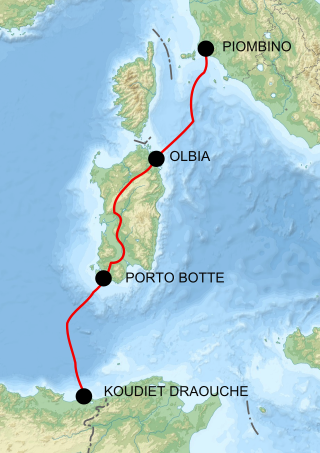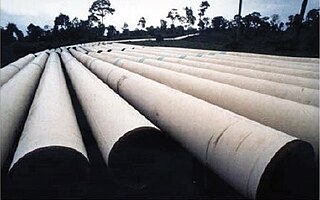The Shtokman field, one of the world's largest natural gas fields, lies in the northwestern part of the South Barents Basin in the Russian sector of the Barents Sea, 600 kilometres (370 mi) north of Kola Peninsula. Its reserves are estimated at 3.8 trillion cubic metres of natural gas and more than 37 million tons of gas condensate.

Sonatrach is the national state-owned oil company of Algeria. Founded in 1963, it is known today to be the largest company in Africa with 154 subsidiaries, and often referred as the first African oil "major". In 2021, Sonatrach was the seventh largest gas company in the world.
Blue Stream is a major trans-Black Sea gas pipeline that carries natural gas to Turkey from Russia. The pipeline has been constructed by the Blue Stream Pipeline B.V., the Netherlands based joint venture of Russian Gazprom and Italian Eni. The Blue Stream Pipeline B.V. is an owner of the subsea section of pipeline, including Beregovaya compressor station, while Gazprom owns and operates the Russian land section of the pipeline and the Turkish land section is owned and operated by the Turkish energy company BOTAŞ. According to Gazprom the pipeline was built with the intent of diversifying Russian gas delivery routes to Turkey and avoiding third countries.
Nord Stream is a pair of offshore natural gas pipelines in Europe that run under the Baltic Sea from Russia to Germany. It consists of the Nord Stream 1 (NS1) pipeline running from Vyborg in northwestern Russia, near Finland, and the Nord Stream 2 (NS2) pipeline running from Ust-Luga in northwestern Russia near Estonia. Both pipelines run to Lubmin in the northeastern German state of Mecklenburg-Vorpommern. Each pipeline contains two pipes, denoted A and B; each of the four pipes is approximately 1,200 kilometres (750 mi) long and with approximate diameters of 1,220 millimetres (48 in). The combined capacity of the four pipes is 110 billion cubic metres per annum of natural gas.
The BBL Pipeline is a natural gas interconnector between the Netherlands and the United Kingdom.

The South Caucasus Pipeline is a natural gas pipeline from the Shah Deniz gas field in the Azerbaijan sector of the Caspian Sea to Turkey. It runs parallel to the Baku–Tbilisi–Ceyhan pipeline (oil).

The Langeled pipeline is an underwater gas pipeline transporting Norwegian natural gas to the United Kingdom. Before the completion of the Nord Stream 1 pipeline, it was the longest subsea pipeline in the world.

The Trans-Saharan gas pipeline is a planned natural gas pipeline from Nigeria to Algeria. It is seen as an opportunity to diversify the European Union's gas supplies.

GALSI was a planned natural gas pipeline from Algeria to Sardinia and further northern Italy, as an extension to the TransMed Pipeline.

The Greenstream pipeline, part of the Western Libyan Gas Project, is a natural gas submarine pipeline running from western Libya to the island of Sicily in Italy.

The Trans-Mediterranean Pipeline is a natural gas pipeline from Algeria via Tunisia to Sicily and thence to mainland Italy. An extension of the TransMed pipeline delivers Algerian gas to Slovenia.

The Maghreb–Europe Gas Pipeline is a natural gas pipeline, which links the Hassi R'Mel gas field in Algeria through Morocco with Cordoba in Andalusia, Spain, where it is connected with the Spanish and Portuguese gas grids. Before the operation of the pipeline ceased in October 2021, it used to supply mainly Spain and Portugal, as well as Morocco with natural gas.
The West African Gas Pipeline (WAGP) is a natural gas pipeline to supply gas from Nigeria's Escravos region of the Niger Delta area to Benin, Togo and Ghana. It is the first regional natural gas transmission system in sub-Saharan Africa.
The Urucu–Manaus pipeline is a natural gas pipeline in Brazil. It allows use of the natural gas from Urucu, which is the largest onshore natural gas reserve in Brazil. The gas is used to substitute diesel and fuel oil for the electricity production in the state of Amazonas, and the pipeline supplies cities of Coari, Codajás, Anori, Anamã, Caapiranga, Manacapuru, Iranduba, and Manaus. The pipeline was inaugurated on 26 November 2009, and it is operated by Transportadora Urucu-Manaus S.A., a subsidiary of Petrobras.

South Stream is a canceled pipeline project to transport natural gas of the Russian Federation through the Black Sea to Bulgaria and through Serbia, Hungary and Slovenia further to Austria. It was never finished.

The Trans Adriatic Pipeline is a natural gas pipeline operational since 2020, running from Greece through Albania and the Adriatic Sea to Italy. It is the final section of the Southern Gas Corridor originating in Azerbaijan. As of 2022, capacity is 10 bcm per year.
The Dolphin Gas Project is the natural gas project of Qatar, the United Arab Emirates, and Oman. It is the Gulf Cooperation Council's first cross-border refined gas transmission project and the largest energy-related venture ever undertaken in the region.

The Yadana gas field is an offshore gas field in the Andaman Sea. It is located about 60 kilometres (37 mi) offshore to the nearest landfall in Myanmar. The gas field is an important source of revenue for the Myanmar Army. Gas from Yadana is used to generate about 8 percent of the electricity in neighbouring Thailand and around half of all electricity in Myanmar’s largest city, Yangon.

Gjøa oilfield is an oilfield in the Norwegian section of the North Sea. It lies about 70 kilometres (43 mi) off the Troll field.
Energy in Algeria encompasses the production, consumption, and import of energy. As of 2009, the primary energy use in Algeria was 462 TWh, with a per capita consumption of 13 TWh. Algeria is a significant producer and exporter of oil and gas and has been a member of the Organization of the Petroleum Exporting Countries (OPEC) since 1969. It also participates in the OPEC+ agreement, collaborating with non-OPEC oil-producing nations. Historically, the country has relied heavily on fossil fuels, which are heavily subsidized and constitute the majority of its energy consumption. In response to global energy trends, Algeria updated its Renewable Energy and Energy Efficiency Development Plan in 2015, aiming for significant advancements by 2030. This plan promotes the deployment of large-scale renewable technologies, such as solar photovoltaic systems and onshore wind installations, supported by various incentive measures.









